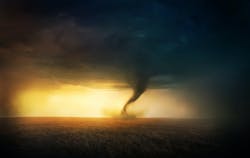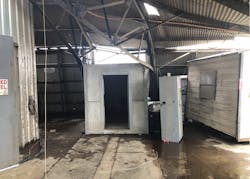If You Think It Can’t Happen to You, Think Again: A Tornado Story
It’s a phone call that no EHS or operations leader ever wants to receive on a Friday evening. “The Amory plant was just hit by a tornado.”
The immediate and obvious question was, “Is everybody okay?” After a short pause, “We don’t know yet but we are trying to find out.” For 20 agonizing minutes we waited for the return call. “Everybody at the plant was in the shelter and they are all okay.”
The next step was to account for the rest of the team. This proved to be much more difficult as cellular service, electricity and even landlines were all affected in the area. By early Saturday morning 85% of the team was accounted for but it would take until mid-day Sunday to account for those remaining. Thankfully, they were all okay and reported only minor to moderate damage to their homes and vehicles.
Since the event occurred just after dark, assessing the plant could not take place until first light on Saturday morning. The first photos showed incredible devastation to both the plant and community. Looking at the photos, it was remarkable that no one was injured during the event. Additional assessments determined that some structures were not safe to enter. The roof on the administration building was completely torn off. The main manufacturing building and control room sustained significant damage and had partially collapsed on the tornado shelter during the event.
What Went Right
By focusing on operational discipline, companies and locations can ensure teams are ready when the unthinkable happens. Utilizing formal processes, questioning attitude and striving to constantly learn are cornerstones to succeeding where others might not have. Backing up one another by looking for what may have been missed or not addressed, while uncomfortable, leads to better outcomes in such situations.
Many times, articles like this talk about “what went wrong” or gaps and opportunities that hindered a better response. This article isn’t about that. Even though learnings will be identified, and things will be improved across our enterprise, this article will focus on three things that went right.
- First, a committed leadership team in Operations ensured that the expectations for emergency response were clear and adhered to. Every leader in the company has stressed the expectation that production, under no circumstances, is more important than safety. The critical links in this chain are the plant manager and regional operations directors. Often CEOs and VPs set the expectation, but the next level down doesn’t carry it forward. Fortunately, this wasn’t the case in Amory.
The regional operations director and plant manager understood the message and set clear and concise expectations that in the event of a tornado warning, the plant was to be shut down in a safe manner and everyone moved to shelter as quickly as possible. This made a critical difference in the speed in which the team reacted. - Second, the workforce was trained on what to do in the event of an emergency. This doesn’t mean sitting in a conference room talking about what we’d do in an emergency, but actual drills were led by a regional EHS leader and evaluated for effectiveness. Fortunately, this team had received training in 2022 and had experienced another situation in the previous month where a nearby tornado warning sent them to shelter.
Doing “tabletop” drills is not enough—people need to practice. Muscle memory needs to be set so that reacting to a real event when the time comes is automatic. Failing to do drills or just checking boxes on a form while talking to the team would not have given the Amory team the ability to react and reach shelter in time. Had they reached shelter even one minute later, results would have been catastrophic. - Finally, every location needs to ensure that employee contact lists are current and are updated on a frequent basis. Additionally, having a mass communication system to contact all employees simultaneously is much faster than traditional phone trees, etc. The Amory team was sent a text/phone survey via one of these systems early Saturday, giving them the opportunity to respond that they were okay, had damage to their homes or needed immediate help.
Delays can be expected in situations where cellular towers and phonelines have been impacted, but being able to get status on team members and share vital information is crucial. In some cases, employees may not have notified HR of a change in phone numbers, hindering efforts to contact them.
While the Amory plant sustained significant damage, nobody was hurt. Cleanup and restart planning is underway, and the team is working with outside resources to make the location safe for operations. This would not have been possible were it not for committed leadership, a trained and drilled workforce and a rapid means of communicating with all employees to ensure their safety and wellbeing. This team is the true definition of #AmoryStrong!
Practicing operational discipline when it comes to emergency response isn’t a flavor of the month. Don’t say, “That can’t happen to us” or “We’ve got that buttoned up.” Question everything, make sure your processes are formal enough and that you’ve imparted the right knowledge and training/practice to all team members. Don’t worry about making people uncomfortable with your challenges. This isn’t personal, it’s about having things in-place that just may save someone’s life!
Rest assured, there are many who have learned that it can happen to you, so don’t be caught unprepared.
Chris Bulls, CSP, is director of EHS with Enviva Biomass, a producer of sustainable wood pellets, which provide a low-carbon alternative to fossil fuels.
About the Author
Chris Bulls
Director of EHS
Chris Bulls, CSP, is director of EHS with Enviva Biomass, a producer of sustainable wood pellets, which provide a low-carbon alternative to fossil fuels.



